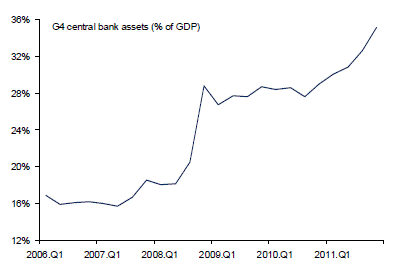|
A very well-thought report from Morgan Stanley on the impact and limits of balance sheet expansions by central banks, here are a few excerpts:
Onwards and Upwards: G4 Central Bank Balance Sheets

Source: National sources, Haver Analytics, Morgan Stanley Research
-
"Central banks have used their balance sheets as a macroeconomic buffer during the crisis, performing a unique stabilisation function. Yet although there are no technical limits to balance sheet expansion, central banks should not jeopardise confidence in their own liabilities by issuing too many of them - confidence is the ultimate constraint.
-
While balance sheet policy is by now firmly established as a central bank policy tool, the deployment of outright asset purchases for macroeconomic reasons should be confined to extraordinary circumstances - occasions where nominal interest rates are at the zero lower bound or the transmission mechanism is broken.
-
However desirable, reverting large balance sheets to normal is likely to take a long time - so long, that balance sheet expansion could end up being quasi-permanent. This could be inflationary unless the size of the monetary base keeps in lockstep with the evolution of the public's liquidity preference."
(...)
"Central banks have used their balance sheets to effect:
- Liquidity transformation, by exchanging illiquid assets for liquid ones (T-bills and bank reserves, i.e., their own liabilities); often hand-in-hand with
- Maturity transformation, by exchanging long-term assets for liquid assets (again, their own liabilities); and
- Risk transformation, by exchanging risky assets for safe ones (again, their own liabilities)."
"In short, central banks have, through expanding their own balance sheets, in effect liquefied the private sector’s balance sheet and taken the unwanted assets off it. That is, central banks have used their balance sheets to act as a buffer, thus performing a crucial intertemporal stabilisation function. Note that central banks’ balance sheet cannot, and should not, prevent deleveraging. Rather, they facilitate a smoother adjustment over time so as to alleviate the adverse macroeconomic effects of (too rapid) private sector deleveraging."
|